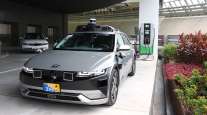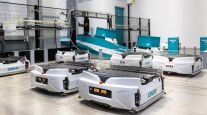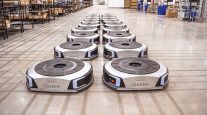Managing Editor, Features and Multimedia
The Road to the Autonomous Truck
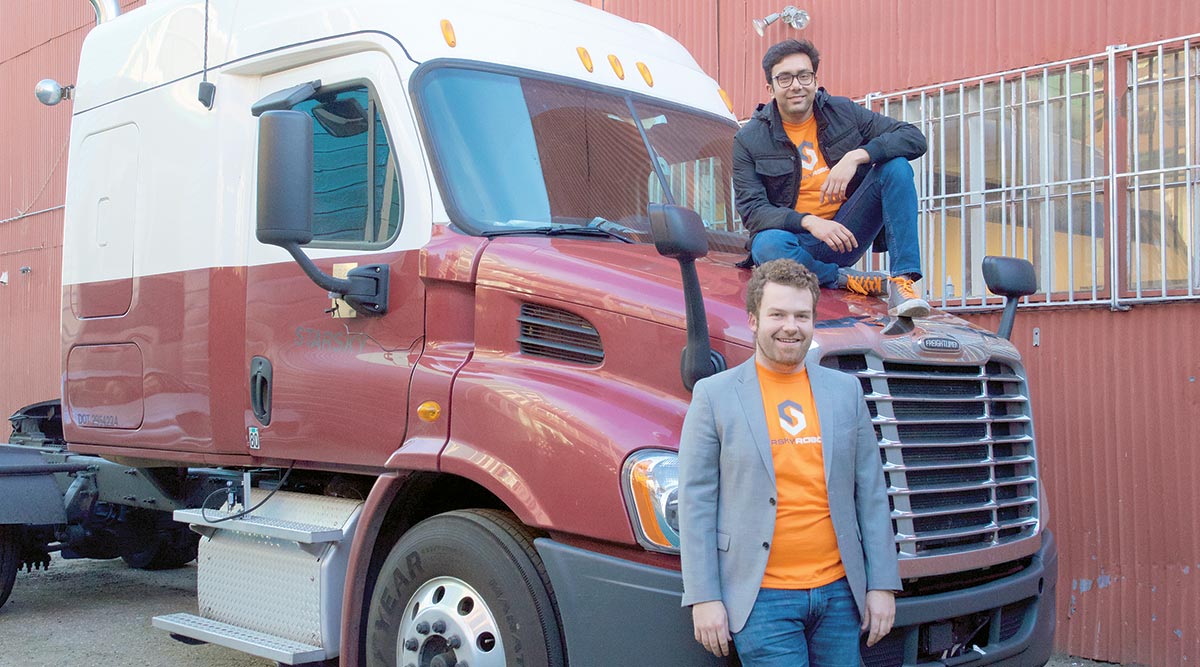
This story appears in the June 12 print edition of iTECH, a supplement to Transport Topics.
The trucking industry’s march toward self-driving trucks is gaining momentum as new developers attempt to accelerate the pace of innovation.
Ride-hailing giant Uber Technologies Inc. and a growing number of Silicon Valley tech startups are racing to develop systems that enable heavy-duty trucks to drive themselves on highways with no driver input — and perhaps no driver at all.
That’s a more aggressive approach to automation than the vision outlined by the industry’s more established players, which are investing in systems designed to assist rather than replace the driver.
Truck manufacturers and their braking suppliers are pursuing a more gradual move toward higher automation, starting with the next wave of advanced driver-assist features such as lane keeping assist, traffic jam assist and truck platooning.
BEST OF JUNE iTECH: More stories, columns
LIVEONWEB: Watch replay of 'The Road to Automated Driving'
While that path may lead eventually to highway “autopilot” systems that would enable the driver to disengage from the act of driving under certain conditions, truck makers remain adamant that the driver will continue to play an essential role in trucking for the foreseeable future.
Tech startups, in contrast, see unmanned trucks on highways as a much nearer-term goal, at least in a limited capacity.
Industry consultant Richard Bishop said these tech startups simply won’t attract funding if they take a conservative approach to automation.
“They’ve got to shoot for the stars, and that’s what they’re doing,” he said. “On paper, the business case is awesome if you can go driverless.”
While truck makers and startups see automation as an opportunity to achieve unprecedented gains in road safety and fleet productivity, they are offering competing pathways to that goal — the fast track represented by the startups and the more measured approach pursued by the truck makers.
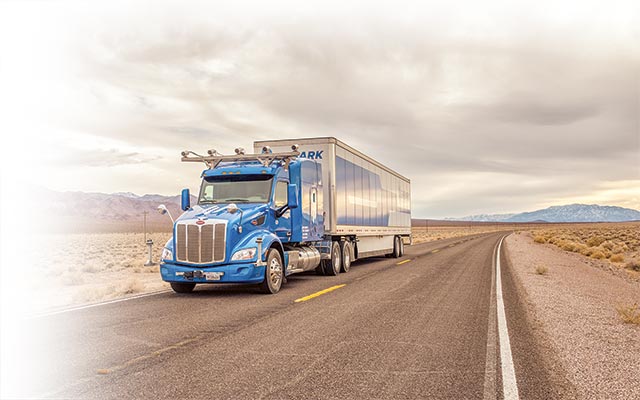 Embark
Embark “They’re challenging each other. That’s changing the market’s dynamics,” said Bishop, who was previously program manager for vehicle-highway automation at the Federal Highway Administration. He also chairs the Technology & Maintenance Council’s task force on automated driving and platooning.
Bishop predicted that the tech startups will begin small, isolated deployments within the next few years.
“There’s going to be a state that wants to be the first, and they’ll find a very remote freight route where they’ll allow driverless,” he said. “It’s just a question of whether they’ll scale up.”
Those limited rollouts would also give the truck makers a test case to examine as they develop their own product plans.
In the meantime, Uber and startups such as Embark and Starsky Robotics are pushing the envelope in the automated trucking arena.
Uber opened the eyes of many in the industry in October when its self-driving truck business delivered a load of beer for Anheuser-Busch in Colorado.
That truck still had a driver onboard, but he handed over control to the self-driving system for 120 miles of highway driving. Camera, radar and lidar sensors mounted on the vehicle monitored the truck’s surroundings as the driver watched from the sleeper berth.
Uber jumped into the self-driving truck business in August through its $680 million acquisition of Otto, a startup founded in January 2016 by former Google engineers. Uber has since combined Otto with its Advanced Technology Group, which develops self-driving technology for both cars and trucks. Uber retired the Otto name in April.
“We’re continuing to make strides in our program and test our technology,” said Alden Woodrow, product lead for Uber ATG.
The goal of the Uber ATG trucks program, he said, is to deliver a system that handles highway driving safely from exit to exit. “This means never requiring a driver to quickly take over control in unexpected circumstances.”
The company would not say how many miles of testing it has completed or offer a timeline for a commercial launch, but Woodrow said the team “is working hard to bring the tech to market as soon as possible.”
While Uber continues to refine its self-driving technology, it also faces a legal battle with Alphabet Inc.’s Waymo unit, formerly the Google self-driving car program. Waymo filed a lawsuit earlier this year accusing Uber of stealing its proprietary lidar sensor designs. Uber has denied wrongdoing.
Embark, a startup based in San Mateo, Calif., unveiled its own self-driving truck system to the public in February.
The company’s vision is to produce technology that allows driverless trucks to travel from exit to exit on highways while continuing to rely on humans for driving in urban and suburban environments, CEO and co-founder Alex Rodrigues said at the time.
He predicted that driver-assist systems will be “leapfrogged” by full autonomy, which he said offers a “much stronger business case.”
Embark’s system uses camera, radar and lidar sensors along with GPS to monitor the truck’s environment and position.
The company is backed by Maven Ventures, which sold its previous investment in self-driving technology, Cruise Automation, to General Motors Corp. last year.
Another tech startup, Starsky Robotics, is taking a radically different approach: remote-controlled trucks piloted from afar by specially trained commercial drivers.
CEO Stefan Seltz-Axmacher said the company’s goal is to take drivers out of the cab and move them into offices, where they can operate the vehicle remotely based on video feeds from onboard cameras.
That, he said, would make the driver’s job more appealing and address the chronic driver shortage that continues to plague longhaul, over-the-road trucking.
“When you think of the problem that we’re solving as the driver shortage, any product that requires a human being to be in the truck doesn’t seem like a product. None of it solves that problem,” he said.
Seltz-Axmacher said Starsky’s technology will enable unmanned trucks to drive autonomously on the highway and will rely on the company’s remote drivers on other roads.
Rather than selling its technology directly, Seltz-Axmacher sees Starsky’s business model as something akin to a “truck driver staffing agency” for trucking companies.
Starsky would outfit customers’ trucks with the required technology, then drivers employed and trained by Starsky would operate those trucks remotely. Trucking companies would pay Starsky by the mile, much like a normal driver, Seltz-Axmacher said.
Starsky has been running its technology on public roads since December. The company has had a driver onboard in all testing thus far but aims to haul freight with an unmanned truck by the end of the year under certain limited conditions.
However, Starsky’s business model eventually will require a federal policy change, Seltz-Axmacher said. Companies won’t allow an unmanned truck to haul their freight unless Starsky has cargo insurance, which it can only get if its unmanned trucks are explicitly legal, he said. “We need this technology to be specifically enabled at the federal level.”
The San Francisco-based startup has 19 employees and $3.8 million in venture capital backing, he said.
While tech startups try to make their mark on the trucking industry, original equipment manufacturers continue to make their own investments in driver-assist and automated driving technologies.
Daimler Trucks generated widespread discussion across the industry with the unveiling of its Mercedes-Benz Future Truck and Freightliner Inspiration Truck self-driving concept vehicles, introduced in 2014 and 2015, respectively. Those trucks featured the company’s Highway Pilot system, which automates on-highway driving and allows the driver to relax or perform other tasks from the driver’s seat.
When Daimler first demonstrated Highway Pilot three years ago, the company set 2025 as its target year for the commercial introduction of that technology.
While Daimler always knew it would require a lot of work to fully realize that level of automation, it now appears to be a “steeper climb” than first thought, said Derek Rotz, director of advanced engineering at Daimler Trucks North America.
Programming a self-driving truck to change lanes, overtake other vehicles and operate in adverse weather conditions all present added complexity, he said.
That being said, the development of Highway Pilot continues to evolve, with the effort currently focusing on “sensor fusion” — combining information from onboard camera and radar systems to provide a more comprehensive view of other vehicles as well as pedestrians.
“Until we reach the point where there are zero accidents on the road, we’ve got work to do there,” Rotz said.
He also reiterated Daimler’s view that a trained driver will remain “indispensable” to trucking for the foreseeable future.
Even at Level 4 automation, where the truck can handle all steering, braking and acceleration, drivers still perform many functions beyond operating the vehicle, such as cargo securement, adding snow chains to tires and putting out cones at roadside in the event of a breakdown.

“At that point it’s difficult to see how to automate,” Rotz said.
Kenworth Truck Co. and Peterbilt Motors Co., both divisions of Paccar Inc., recently outlined their plans for advanced driver-assist systems, or ADAS, and automated driving at the Mid-America Trucking Show in March.
“The future isn’t set in terms of how autonomous and ADAS will get traction, but there’s a lot of opportunity,” said Kyle Quinn, senior vice president at Paccar and general manager at Peterbilt.
Scott Newhouse, Peterbilt’s chief engineer, said the truck maker plans to offer ADAS technologies such as traffic jam assist, lane keeping, platooning and auto docking to improve driver safety and productivity through reduced driver effort. The company aims to introduce those types of capabilities “in the next several years,” he said.
The lane keeping technology will help drivers stay in their lane by using torque control at the wheel, but they should still keep their hands on the wheel.
“He’s still driving the vehicle; this is to assist him,” Newhouse said. “That’s really where we are at in our initial stage, and then the technology can take us further in the future.”
Patrick Dean, chief engineer at Kenworth, said the industry is “very much still in an exploratory mode.”
Kenworth is currently focused on Level 2 automation, which incorporates steering assistance, with plans to then move to Level 4, where the driver is no longer required to monitor the vehicle’s progress, at least under certain conditions, he said.
“We have a lot of concern about Level 3,” where the truck can drive itself but the driver might need to respond to requests to intervene or retake control, he said.
Dean also sounded a note of caution on new technology developers that are racing to introduce self-driving systems.
“They are pushing as fast as they can, and sometimes I think maybe not enough care is given to what it means to have an 80,000-pound vehicle driving down the road,” he said. “We don’t want to create the perception for the driver that the truck is in control when in an edge case, it’s not going to be.”
Paccar also recently announced a partnership with Nvidia, a provider of graphics processing technology, to support the move to more advanced automated driving features.
Navistar Inc. is examining next-level driver-assist capabilities such as truck platooning and lane management with automated steering.
“As we look to the future, the development of ADAS technologies is going to expand enormously,” said Darren Gosbee, the truck maker’s vice president of powertrain and advanced technologies.
On the subject of driverless trucks, Gosbee said he believes “there will come a time when we get to that point,” but it will likely be 15 years from now, or even longer.
Driverless trucks will require the automation of a lot of things that aren’t so obvious, such as monitoring tire pressure and oil and fuel levels, he said. Even basic inspection items such as checking lug nuts on wheels could present a problem.
“If you do away with the driver, there are some really fundamental things we have to address,” Gosbee said.
Truck platooning technology is on track to become the newest driver- assist capability to reach the market.
Peloton Technology said the first commercial deployments of its platooning system are scheduled for later this year, when the company will begin filling pre-orders.
Peloton’s driver-assist platooning system uses vehicle-to-vehicle communications to synchronize the braking and acceleration of a pair of Class 8 trucks, enabling them to travel safely at shorter, more aerodynamic following distances. While platooning, the system can generate fuel savings of up to 10% for the following truck and 4.5% for the lead truck, the company said.
Peloton recently formed a partnership with fleet telematics provider Omnitracs aimed at making it easier for fleets to take advantage of platooning opportunities through dispatch, routing and navigation services.
While Peloton’s system will begin with two-truck platooning, the company also has expressed interest in expanding the convoys to three or more trucks and bringing more automation to the rear truck, which potentially could help fleets reduce labor costs, CEO Josh Switkes said earlier this year.
Volvo Trucks also is investing in platooning technology.
The truck maker demonstrated a partially automated truck platoon in March in cooperation with Partners for Advanced Transportation Technology at the University of California, Berkeley. Three Volvo tractors hauled cargo containers at the Port of Los Angeles and along Interstate 110 to highlight the technology’s potential to reduce greenhouse gas emissions and improve safety.
“Truck platooning can benefit freight companies and professional drivers alike through safer, more fuel-efficient operations,” said Magnus Koeck, vice president of marketing and brand management at Volvo Trucks.
Volvo said platooning “presents the best near-term opportunity for leveraging any level of autonomous technology for on-highway operations, where a skilled professional driver remains vitally important.”
Confined environments remain the most feasible applications for fully autonomous vehicles, Volvo said. The company has demonstrated a driverless truck for mining operations in Sweden.

Suppliers of braking and safety systems are supporting truck makers on the path to automation.
Joe McAleese, chairman at Bendix Commercial Vehicle Systems, said the fully autonomous truck is still “a very long way off,” but today’s active safety systems, such as electronic stability control and collision mitigation, are paving the way.
“As we implement those we’re making our highways safer,” McAleese said. “Eventually we’ll get enough technologies for a driverless truck potentially. All the things we’re doing are the foundation for that future autonomous vehicle.”
Along the way, the integration of automated braking and steering capabilities will be “inevitable,” he said, adding that Bendix could morph into a systems integrator for automated trucks.
“The level of integration we need to have [for] a fully autonomous truck is tremendous,” McAleese said.
Fred Andersky, director of customer solutions and government and industry affairs at Bendix, said the advance of automated driving will depend not only on the technology itself, but also on the broader economic and regulatory ecosystem that will either speed or slow its implementation.
Fleets will need to see a proven return on investment, he said, adding that the technology also will depend on legislation and regulation, as well as acceptance and understanding from society as a whole.
Andersky said Bendix aims to add early steering control capabilities to its active safety systems by 2021. That could enable features such as lane keeping, lane centering or torque assist technologies that make it easier to steer. The Bendix team has been working on steering applications with Tedrive, a Germany-based automated steering firm acquired last year by Knorr-Bremse Group, Bendix’s parent company.
Wabco Holdings, another supplier of active safety technologies, also is looking at ways to incorporate active steering into its systems.
Wabco and steering supplier ZF have jointly developed a prototype for evasive maneuver assist, a safety capability that adds a steering component to collision avoidance. Evasive maneuver assist is designed to help the driver safety steer around a vehicle stopped on the road ahead when it is not possible to avoid a collision through braking alone.
“There has never been a more exciting time when technology is advancing so rapidly,” said Jon Morrison, Wabco Americas president.


